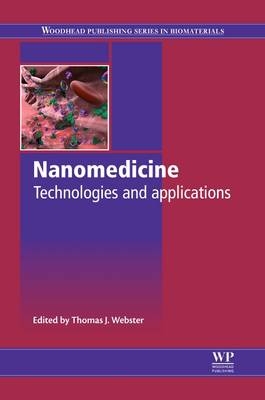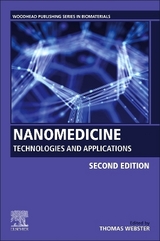
Nanomedicine
Woodhead Publishing Ltd (Verlag)
978-0-85709-233-5 (ISBN)
- Titel erscheint in neuer Auflage
- Artikel merken
Nanotechnology is at the forefront of advances in medicine. Nanomedicine: Technologies and applications provides an important review of this exciting technology and its growing range of applications.
After an introduction to nanomedicine, part one discusses key materials and their properties, including nanocrystalline metals and alloys, nanoporous gold and hydroxyapatite coatings. Part two goes on to review nanomedicine for therapeutics and imaging, before nanomedicine for soft tissue engineering is discussed in part three, including organ regeneration, skin grafts, nanotubes and self-assembled nanomaterials. Finally, nanomedicine for bone and cartilage tissue engineering is the focus of part four, with electrically active biocomposites as smart scaffolds investigated, as is cartilage and bone tissue engineering, regeneration and replacement.
With its distinguished editor and international team of expert contributors, Nanomedicine: Technologies and applications is an indispensable guide for all those involved in the research, development and application of this exciting technology, whilst providing a comprehensive introduction for students and academics interested in this field.
Dr Thomas J. Webster is an associate professor for the Division of Engineering and Department of Orthopaedics at Brown University, USA. He directs the Nanomedicine laboratory which designs, synthesizes, and evaluates nanomaterials for various implant applications and is noted for his work in this area.
Contributor contact details
Woodhead Publishing Series in Biomaterials
Dedication
Part I: Materials, properties and considerations
Chapter 1: Introduction to nanomedicine
Abstract:
1.1 Introduction: basic concepts of nanomedicine
1.2 Public perception of nanomedicine
1.3 Scientific principles and applications of nanomedicine
1.4 Future trends in nanomedicine
Chapter 2: Trends in nanomedicine
Abstract:
2.1 Introduction
2.2 The rise of nanomedicine
2.3 Diagnostics and medical records
2.4 Treatment
2.5 Future trends
Chapter 3: Biomedical nanocrystalline metals and alloys: structure, properties and applications
Abstract:
3.1 Introduction
3.2 Synthesis and structure of nanocrystalline metals and alloys
3.3 Properties of nanocrystalline metals and alloys
3.4 Biocompatibility of nanocrystalline metals and alloys
3.5 Applications of nanocrystalline metals and alloys
3.6 Future trends
3.7 Sources of further information and advice
Chapter 4: Nanoporous gold for biomedical applications: structure, properties and applications
Abstract:
4.1 Introduction
4.2 Medical applications
4.3 Biosensor applications
4.4 Alloy formation
4.5 Dealloying of gold–silver alloy
4.6 Mechanical properties of nanoporous gold
4.7 Electronic properties of nanoporous gold
4.8 Conclusions
Chapter 5: Hydroxyapatite (HA) coatings for biomaterials
Abstract:
5.1 Introduction
5.2 Hydroxyapatite (HA) coatings
5.3 HA coatings by plasma spraying
5.4 Properties of plasma-sprayed coatings
5.5 Biomimetic HA coatings
5.6 HA coatings by sol-gel deposition
5.7 Miscellaneous deposition techniques for HA coatings
5.8 Conclusions
5.9 Future trends
5.10 Acknowledgement
Part II: Nanomedicine for therapeutics and imaging
Chapter 6: Calcium phosphate-coated magnetic nanoparticles for treating bone diseases
Abstract:
6.1 Introduction
6.2 Iron oxide magnetic nanoparticle synthesis
6.3 Surface modification of iron oxide magnetic nanoparticles
6.4 Characterization of iron oxide magnetic nanoparticles
6.5 Biological applications of magnetic nanoparticles
6.6 Conclusions
6.7 Future trends
Chapter 7: Orthopedic carbon nanotube biosensors for controlled drug delivery
Abstract:
7.1 Introduction
7.2 Carbon nanotubes for electrochemical biosensing
7.3 Carbon nanotube-based in situ orthopedic implant sensors
7.4 Electrically controlled drug-delivery systems for infection and inflammation
7.5 Critical issues in developing in situ orthopedic implantable sensors and devices
7.6 Conclusions
Chapter 8: Nanostructured selenium anti-cancer coatings for orthopedic applications
Abstract:
8.1 Introduction
8.2 Selenium as an anti-cancer implant material
8.3 Nanostructured selenium coatings: a novel approach of using selenium to create anti-cancer biomaterials
8.4 In vitro biological assays for uncoated and selenium-coated metallic substrates
8.5 The effectiveness of titanium and stainless steel substrates
8.6 Coarse-grained Monte Carlo computer simulation of fibronectin adsorption on nanometer rough surfaces
8.7 Conclusions
Chapter 9: Nanoparticulate targeted drug delivery using peptides and proteins
Abstract:
9.1 Introduction
9.2 Peptides and proteins for targeted drug delivery
9.3 Drug-peptide conjugates
9.4 Peptide-functionalized drug delivery systems
9.5 Peptide-targeted drug delivery across the intestine
9.6 Peptide-targeted drug delivery across the blood-brain barrier (BBB)
9.7 Peptide-targeted drug delivery for cancer applications
9.8 Peptide-targeted drug delivery for the liver
9.9 Conclusions and future trends
Chapter 10: Nanotechnology for DNA and RNA delivery
Abstract:
10.1 Introduction to DNA and RNA delivery
10.2 Advanced DNA/RNA delivery approaches in nanotechnology
10.3 Nanomaterial applications for DNA/RNA delivery
10.4 Novel vaccines
10.5 Molecular probes and images
10.6 Conclusions and future trends
Chapter 11: Gold nanoshells for imaging and photothermal ablation of cancer
Abstract:
11.1 Introduction
11.2 The impact of cancer
11.3 Cancer biology
11.4 Nanotechnology and cancer treatment
11.5 Nanoshells
11.6 Conclusions and future trends
11.7 Sources of further information and advice
11.8 Acknowledgments
Chapter 12: Microfluidics for testing and delivering nanomedicine
Abstract:
12.1 Introduction
12.2 Microfluidics
12.3 Testing of nanomedicine with microfluidic instruments
12.4 Delivery of nanomedicine using microfluidic technology
12.5 Nanoparticles
12.6 Conclusions and future trends
Chapter 13: Zinc oxide nanowires for biomedical sensing and analysis
Abstract:
13.1 Introduction
13.2 Electrode growth and preparation
13.3 Sensors and functionalization
13.4 Measurement and results
13.5 Conclusions
Part III: Nanomedicine for soft tissue engineering
Chapter 14: Nanotechnology and tissue-engineered organ regeneration
Abstract:
14.1 Introduction
14.2 Nanotechnology and tissue engineering
14.3 Nanotechnology and organ regeneration
14.4 Future trends and challenges
Chapter 15: Rapid fabrication of biomimetic nanofiber-enabled skin grafts
Abstract:
15.1 Introduction
15.2 Autologous skin tissue engineering for wound healing
15.3 The effects of microenvironment on the formation of skin substitute
15.4 Production of biomimetic nanofibers using electrostatic spinning
15.5 Layer-by-layer assembly of cells into 3-D constructs using electrospun nanofibers
15.6 Rapid formation of skin grafts using the nanofiber-enabled cell-layering approach
15.7 Future trends and challenges
15.8 Conclusion
15.9 Acknowledgment
Chapter 16: Nanotubes for tissue engineering
Abstract:
16.1 Introduction
16.2 Nanotubes for tissue engineering
16.3 Nanotube applications in tissue engineering
16.4 Nanotubes and their effects
16.5 Conclusions
Chapter 17: Self-assembled nanomaterials for tissue-engineering applications
Abstract:
17.1 Introduction
17.2 Peptide-based self-assembled nanomaterials
17.3 Applications of peptide-based materials in tissue engineering
17.4 Nucleic acid-based nanomaterials
17.5 Applications of rosette nanotubes (RNTs) in bone and cartilage tissue engineering
Part IV: Nanomedicine for bone and cartilage tissue engineering
Chapter 18: Electrically active biocomposites as smart scaffolds for bone tissue engineering
Abstract:
18.1 Introduction
18.2 Composition and electrical properties of natural bone
18.3 Effect of an external E-field on cells
18.4 Development of hydroxyapatite (HA)-based bone replacement materials
18.5 Conclusions
18.6 Acknowledgement
Chapter 19: Nanotechnology for cartilage and bone regeneration
Abstract:
19.1 Introduction
19.2 Cartilage repair and regeneration
19.3 Bone repair and regeneration
19.4 Future trends and conclusions
Chapter 20: Nanostructured materials for bone tissue replacement
Abstract:
20.1 Introduction
20.2 The need for nano-engineered bone
20.3 Surface properties of orthopedic materials
20.4 Nano coating on conventional surfaces
20.5 Nanomaterials for orthopedic tissue engineering
20.6 Future trends and ethical concerns
20.7 Conclusions
Chapter 21: Nanocomposites for cartilage regeneration
Abstract:
21.1 Introduction
21.2 Design criteria and considerations for cartilage biomaterials
21.3 Biomaterials for cartilage regeneration
21.4 Scaffold fabrication
21.5 Conclusions and future trends
Index
| Reihe/Serie | Woodhead Publishing Series in Biomaterials |
|---|---|
| Verlagsort | Cambridge |
| Sprache | englisch |
| Gewicht | 1180 g |
| Themenwelt | Medizin / Pharmazie ► Physiotherapie / Ergotherapie ► Orthopädie |
| Technik ► Maschinenbau | |
| Technik ► Medizintechnik | |
| ISBN-10 | 0-85709-233-2 / 0857092332 |
| ISBN-13 | 978-0-85709-233-5 / 9780857092335 |
| Zustand | Neuware |
| Haben Sie eine Frage zum Produkt? |
aus dem Bereich



